Abstract
It has become increasingly important to train for an educational culture that makes use of digital technology to enhance its practices. Frameworks such as DigCompEdu enable identification of weaknesses and areas which require more training. This paper presents the results of a case study with 249 participants from a Portuguese University examining differences in the digital competence of teachers according to gender, age, faculty and experience. Based on the data obtained, it was found that there were no significant differences and that it was, therefore, more important to consider training for digital empowerment according to the different areas of the DigCompEdu framework and to address weaknesses found in each of these areas.
1. Introduction
Today we speak, write, read, and communicate very differently from the way we did 500 years ago (Coiro et al. 2008). In fact, how we communicate today is profoundly different from some 50 years ago. For this reason, literacy, and the capacity to understand information presented to us today, has many more dimensions.
The OECD (2005), defining the key competences for 21st century society, highlighted the need to be competent in the use of ‘interactive tools’, including interactive languages, symbols and texts. Since the 1990s, there has been increasing reference to the “digital divide” in international technical reports and in academic documents which goes well beyond access or non-access to the Internet. In 2015, the World Economic Forum stated that the ability to access technological resources, and the provision of education with access to digital resources and which enhanced computational proficiency, would increasingly mark the difference between more and less developed countries (WEF 2015).
However, the question arises of how to define what digital competences are. This construct encompasses the ability to work in digital environments, relating the pedagogical component to the technological and digital component. “Digital competence” results from the development of knowledge and attitudes underpinning the effective use of digital technology in a professional context.
For the development of these competences, it is necessary for citizens to have skills in critical thinking, especially in terms of discerning the use that can be made of different digital technologies and the resources that are accessible using them (European Parliament and the Council 2006; INTEF 2017; Ilomäki et al. 2016), as well as creativity and the confidence to use different digital resources to achieve desired goals with regard to employment, education, leisure, and inclusion and participation in society (INTEF 2017). As Ilomäki et al. (2011) explain, the definition of digital competences entails political and regional issues, stating that it “reflects beliefs and even desires about future needs, and is rooted in economic competition in which new technologies are seen as an opportunity and a solution” (p. 1).
Most authors assume that digital competences are not only important for enhancing performance for personal benefit, but that the mastery of these competences can also contribute to the achievement of collective goals (Erstad 2006; Gansmø 2009; Ilomäki et al. 2016; From 2017; Ferrari 2012; Claro et al. 2018).
To develop citizens’ digital competences, in most OECD countries, it is ministries of education that oversee the promotion of programmes aimed at developing digital competences starting in school. However, in other countries, there are examples of empowerment of specific population groups to reduce digital exclusion, or that seek the empowerment of the whole population. One example is Portugal.
In 2005, the Joint Research Centre of the European Union, through the EU Science Hub, initiated the preparation of a framework for the digital competence of citizens. Its aim was to highlight the potential of digital technologies, not only in education, contributing to pedagogical innovation, but also in lifelong learning, and the need to increase competence in different areas of everyday life of all citizens. In 2017, a framework for educators was prepared titled DigCompEdu, based on awareness of the fundamental need for educators to master several specific digital competences to harness the potential of digital technologies and, thus, enhance and increase innovation in education (Punie and Redecker 2017).
The DigCompEdu framework organises educators’ digital competence into six areas, encompassing the autonomous work of educators, their relationship with their colleagues, and the application of digital competence, not only in their classes, but also for learner empowerment (Dias-Trindade and Moreira 2021). In 2018, a self-reflection tool for measuring educators’ digital competence, DigCompEdu Check In, was developed, enabling each teacher (and potentially the institution where they work) to self-assess their digital competence in each of the six areas of the reference tool and to position themselves according to the six levels of digital competence (in general terms and in each of the six areas). The project includes suggestions for improvement, assuming continuous progression and evolution.
The Government has introduced strategies for the modernisation of Portuguese technological parks, in general, and of schools in particular, and for the training and digital inclusion of all citizens, seeking to train Portuguese citizens through actions centred on education, since a focus on youth training will always prove to be fundamental in both the medium and long term.
This decision is reflected in the project National Digital Skills Initiative e.2030, Portugal INCoDe.2030, started in 2017, to promote a digital competences framework designed for the future and take advantage of the opportunities that may arise from this training. It involves a clear commitment to prepare the younger generation and to respond to three major challenges: to enhance the digital literacy of the entire population, to stimulate employability and vocational training in the area of digital technologies, and to ensure strong participation in international research and development networks and digital knowledge production (Government of Portugal 2017). In the context of the COVID-19 pandemic, the Portuguese Council of Ministers approved the Action Plan for Digital Transition, which is intended to be “the country’s transformation engine” (p. 3), aiming to put into practice a varied set of measures to promote the country’s digitalisation. These measures are organised into three main pillars, the first of which is dedicated to training and digital inclusion and includes education and digital requalification and vocational training.
The focus on training and digital inclusion includes teacher training, both to enable teachers to include digital technology in their teaching practices, but also as a strategy for promoting the digital training of students. This focus, in the case of basic and secondary education, has resulted in extensive teacher training and digital capacity building, based on the training schemes prepared by the Directorate General of Education. In higher education, because of the autonomy that these institutions enjoy, the options pursued have followed diverse paths.
2. The Case of the University of Coimbra
As part of a rectoral strategy aimed at pedagogical innovation at the University of Coimbra, with a vision of monitoring the transversal formative needs of higher education, in July 2020, under the auspices of the vice-rectories in charge of the Assignments of Academic Affairs, Attractiveness, Research and the 3rd study cycle, the rector decided to create the University of Coimbra Special Project for Learning and Pedagogical Innovation (UC-AIPED).
This project emphasised the importance of the quality of higher education in an increasingly interconnected and internationalised society, as a means of overcoming problems and to achieve peace, prosperity and progress (in line with the Fifth Bologna Summit, held in Paris in May 2018). The project adopted a multidisciplinary approach, aiming to “aggregate a whole set of initiatives and strategies that lead to the improvement of learning and pedagogical innovation, stimulating a metamorphosis based on the close relationship between teaching, research and societal challenges, in a national and international perspective, and respecting the specificity of the UC and its scientific and pedagogical mission” (Universidade de Coimbra 2020, p. 176). In the foreground was the need for deeper reflection on the educational content to be prioritised as essential and which promoted critical thinking, understanding, and building and stimulating student autonomy, from a perspective that was not exclusively evaluative, and the importance of the pedagogical relationship as the focal point of motivation, stimulation, learning and reasoned questioning.
The vision that the University “has to reorganise itself, moving from a function of transmitting knowledge to functions of reconstruction, criticism and production of new knowledge” (Nóvoa 2000, p. 132) involves a necessary change of paradigm. This change implies a global vision of the educational system, combining practice, research, and creativity, to achieve the primary objectives of higher education institutions (Dias-Trindade 2021, p. 20).
Although this special project was concerned with more than the educational experience in times of pandemic, it was inevitably influenced by this factor, focusing on activities that had pedagogical innovation as their main objective, but that incorporated activities focused on the development of quality pedagogical practices in a time of pandemic where digital environments and resources were of the utmost importance.
The activities organised by UC-AIPED included teacher training, that involved activities during school break periods for exams, which involved the participation of almost a thousand teachers over two years, including workshops on the computer platforms that the University had been developing, sessions for sharing teaching practices and active learning methodologies with or without digital resources, among others. The fundamental aims of the programme were to promote, for and with the teaching staff of the UC, environments that foster the exchange of experiences, good practice and (co)learning, stimulating the updating and improvement of pedagogical competences, innovative strategies, and methodologies, as well as the implementation of more synergic interaction between teaching, research, and societal challenges.
On the occasion of the 20th anniversary of its foundation (October 2013), the International Consortium for Educational Development (ICED), highlighted the importance of preparing university professors, especially, but not exclusively, at the beginning of their teaching careers (ICED 2014). The UC is very focused on this purpose in line with the European Standards and Guidelines for Quality Assurance in the European Higher Education Area. As highlighted in Standard 1.5: “Institutions should assure themselves of the competence of their teachers (…). The teacher’s role is essential in creating a high-quality student experience and enabling the acquisition of knowledge, competences, and skills. The diversifying student population and stronger focus on learning outcomes require student-centred learning and teaching and the role of the teacher is, therefore, also changing (cf. Standard 1.3). Higher education institutions have primary responsibility for the quality of their staff and for providing them with a supportive environment that allows them to carry out their work effectively” (ENQA 2015, p. 13).
The “perfect storm” mentioned in the World Economic Forum Report (WEF 2018), The Future of Jobs Report, referring to employment trends for 2022, is already a fact in several areas. With the emergence of the fourth industrial revolution, for the first time, the threshold of more than 50% of tasks performed by machines and algorithms, in countless areas of economic activity, will be surpassed. Human-based actions are predicted to constitute 58% of total economic activity in 2022 and 48% in 2025 (in 2018 they comprised 71%). The question “what jobs do we train for” is highly relevant in this context.
The University has a crucial role to play in this area, not only ensuring processes of reskilling and upskilling, but operating on the assumption that the future of work does not depend on more or less pre-determined and rigid careers and training programmes, but instead on a range of competences and the possibility of micro-careers in different domains. We, therefore, call for training that is increasingly anchored in dynamic and transversal learning processes (e.g., critical and analytical thinking, entrepreneurship, innovation and creativity, digital skills, emotional intelligence, adaptability, and teamwork, etc.) reconciling, in a difficult but necessary balance, diversified, comprehensive, and cutting-edge knowledge.
The achievement of this objective, in a consistent and effective way, implies the preparation of teachers to encourage them to “strengthen the link between education and research” and to increase “innovation in teaching methods and the use of new technologies” (ENQA 2015, p. 13); in short, a new mindset stimulated by the internal and external context of the university.
Teacher-training in the UC is thus focused on four main areas to promote “Education 4.0” (WEF 2020) which is more adapted to current and future societal needs. These are described below.
- (a)
- Innovation and creativity: How to stimulate creativity and develop scientific understanding? What methodologies are available and how may they be used for active learning and complex problem-solving? How can different areas of knowledge and experience be connected, promoting collaborative learning?
- (b)
- Values and global citizenship skills: How can wisdom and awareness about the “big picture” be promoted in contrast to specialised and technological knowledge? How can a sense of wider responsibility be facilitated to encourage ethical and sustainable roles in society?
- (c)
- Digital intelligence: How can technology be used as a pedagogical tool? How can the development of digital skills, including the intelligent (ethical, responsible, sustainable) use of technology, be advanced to overcome the “digital divide”.
- (d)
- Personalised and inclusive learning-teaching environment: How can it be ensured that each student experiences the best conditions for learning, including students with special needs, international and multicultural students, and older students? How can personalised attention and individualised learning paths be realised with large classes?
This paper focuses on a particular aspect of teacher training: preparation for digital education, based on analysis of the digital competences of teachers with a view to defining training strategies to integrate the development of digital competences in innovative and quality teaching practices. The objective of the analysis undertaken was to determine if there were significant differences regarding digital competence according to gender, age, faculty or teaching experience, and to understand what kind of CDP activities can or should be promoted.
3. Materials and Methods
Among the activities developed in this programme are training courses dedicated to the use of digital resources in teaching practice. Aware of the importance of adapting this training to the real needs of the teaching staff in the best possible way, the present study was based on the European Union DigCompEdu benchmark. The DigCompEdu CheckIn questionnaire, in a version validated for the Portuguese population by Dias-Trindade et al. (2019), was administered between September and November 2021 to the entire teaching staff of the University. A total of 249 responses were obtained, corresponding to 12.2% of the teaching staff of the institution.
The results obtained will not only help this institution to improve teacher training already planned, but may also serve as an example of how knowledge of personal digital competence can be integrated in teachers’ continuous professional development (CPD). Should this training take into consideration age, gender, experience, or scientific area? Or should the focus be solely on different digital competence areas, such as those described in the DigCompEdu framework (i.e., professional engagement, digital resources, teaching and learning, assessment, empowering learners, and facilitating learners’ digital competence)?
The project was conducted in line with the Ethical Charter published by the Portuguese Society of Education Sciences (SPCE 2014) and followed the guidelines linked to it. As argued by Mainardes and Carvalho (2019), the investigative process was always associated with high levels of vigilance and self-reflexivity in relation to ethical issues.
The respondents’ participation was voluntary, with the ability to withdraw from completing the questionnaire at any time (Bassey and Owan 2019). Responses were anonymous and the data were considered in aggregate, the results being used only to address the objectives of the current research (Bassey and Owan 2019; Creswell 2007).
4. Results
For the average results per level of the DigCompEdu benchmark, there was a preponderance of level B1—Integrator (32.9%), in line with the overall average results of the study (with 38 points out of a possible 84 corresponding to B1). However, 32.1% of the respondents were at the second lowest level A2—Explorer, indicating greater weakness in the pedagogical use of technologies and digital resources (Figure 1).

Figure 1.
Results by level.
In related studies (e.g., Dias-Trindade et al. 2021; Ota and Dias-Trindade 2020; Santo et al. 2022; Santos et al. 2021; Benali et al. 2018), level B1 was also the average result, suggesting a more conservative and exploratory use of digital technologies in educational settings, but also showing a willingness and motivation to evolve and diversify practices. It was also observed that almost one third of the teachers (those with a mean result at A1 level) “have started using digital technologies in some areas of digital competence, without, however, following a comprehensive or consistent approach” (Punie and Redecker 2017).
This indicates a need for training so that teachers can integrate digital resources and strategies in their pedagogical practice. Since the participants were Portuguese higher education teachers, who are not required to undertake pedagogical training to enter their academic career, this may account for the results. We believe that digital competence implies an interaction between pedagogy, technology, and content (in line with the work of Mishra and Koehler (2006) and their TPACK model). It is, therefore, essential that teachers can promote innovative educational scenarios in which digital technology is used to enhance the learning processes of the students involved. We follow the line of reasoning of Wang et al. (2013), who advocate the existence of a set of factors that determine digital fluency, including educational factors related to academic training.
Figure 2 shows the distribution of the participants’ mean scores.
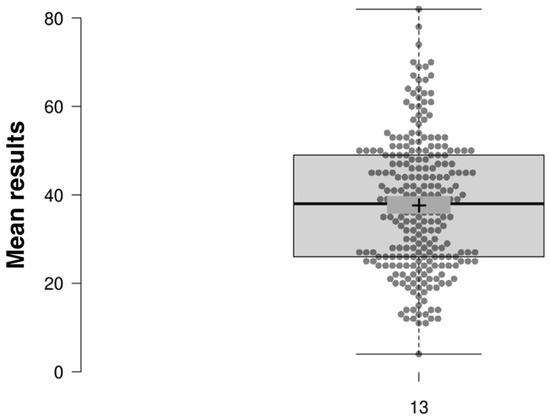
Figure 2.
Distribution of global average scores in violin chart.
As can be seen in Figure 2, there was a greater proportion of intermediate values, with the answers inside the box (corresponding to 50% of the results) being between 26 and 49 points (out of a maximum of 84 points).
The average of the results corresponded to 37.71 and the median was very slightly higher, at 38 points. The Winsorised mean was also calculated, corresponding to 37.43 points, to circumvent the impossibility of verifying whether the minimum and maximum values (respectively 0 and 84 points) correspond to levels of digital fluency.
Following these analyses, we found that all values corresponding to the mean, median and Winsorised mean remained within the interval corresponding to level B1—Integrator (between 33 and 47 points) (Dias-Trindade et al. 2021).
After this first analysis, we sought to gauge whether there were significant differences with respect to gender, age, organic unit and teaching experience of the participants. Wang et al. (2013) present a table that reports the findings of several other studies showing a wide range of characteristics that may be significant for higher or lower digital competence. These authors state that “it is too simplistic to reduce ‘digital nativity’ or digital fluency solely to age and accessibility factors; besides these factors there are psychological, organizational, and social factors that influence digital fluency” (2013, p. 8). Other authors (e.g., Dias-Trindade and Ferreira 2022; European Commission 2013; Gorozidis and Papaioannou 2014) have suggested that confidence and motivation to learn are also relevant factors, as positive correlations between confidence in operational skills to use digital technologies and participation in professional development training have been observed.
4.1. Gender
Figure 3 and Figure 4 indicate the high degree of similarity of results obtained for the two gender groups, consistent with the observations of Benali et al. (2018). Moreover, a more recent study conducted in Spain with university professors (Mora-Cantallops et al. 2022) found no significant difference and, therefore, no impact of gender on the perception of digital competence.
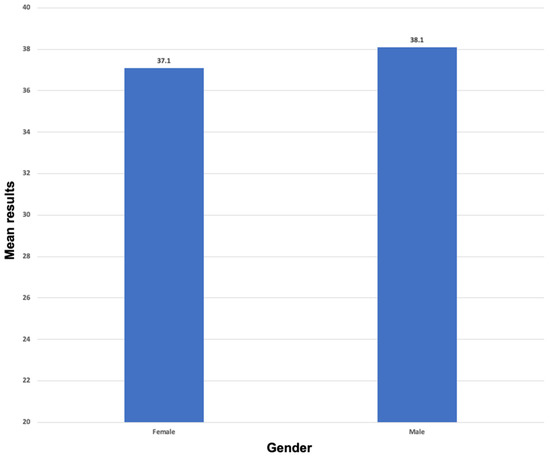
Figure 3.
Mean results by gender.
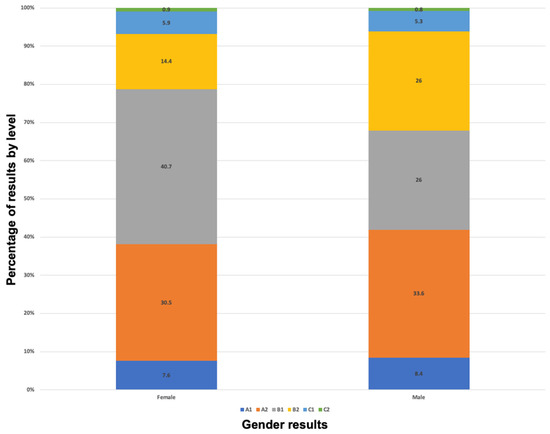
Figure 4.
Percentage of results by level and gender.
Cabero-Almenara and colleagues (Cabero-Almenara et al. 2021) obtained similar results, with the participating teachers in their study, university professors in Andalusia, having overall scores between levels A2 and B1, which were similar for females and males. Other papers investigating this dimension reported similar results (Mora-Cantallops et al. 2022; Tomás-Rojas et al. 2021), with no statistically significant differences found. Only Sánchez-Caballé and Esteve-Mon (2022) have reported results in which females had statistically significant higher scores, both in general and in terms of the different dimensions of the framework.
4.2. Age
Regarding age, there were some interesting results that are worth exploring in detail. On the one hand, no statistically significant differences were observed; however, both the youngest (26 to 30 years old) and the oldest (61 to 65 years old and 66 to 70 years old) groups of teachers were the age groups with the greatest weaknesses. The age groups from 51 to 60 had the highest average scores. These values are consistent with those of several other studies (Dias-Trindade and Santo 2021; Dias-Trindade et al. 2021); however, in the study by Mora-Cantallops et al. (2022), the same was not true, and a clear decrease in digital competence with age was observed (Figure 5).
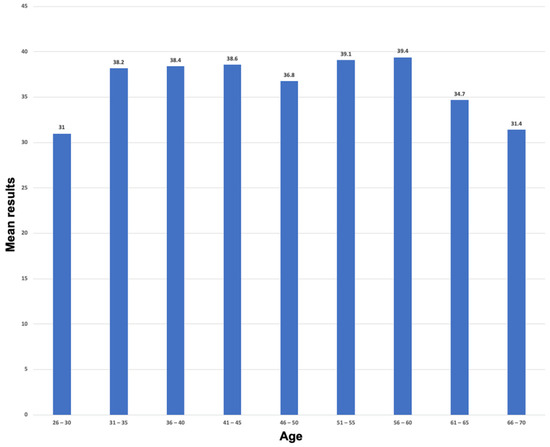
Figure 5.
Mean results by age.
Therefore, we conclude that age, as argued by Wang et al. (2013), may influence the perception of digital competence, but is not a major determinant.
Figure 6 shows the percentage of respondents at each level according to age. There was a relationship between the results for respondents in this study and those of Spanish teachers, since, when we look at Figure 6, it can be seen that there were many more A2 levels in the group of older teachers (38.5% and 60%), and A1 levels (12.8% and 10%), than in the other age groups.
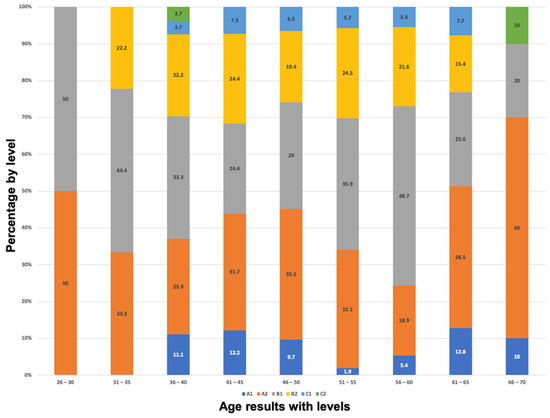
Figure 6.
Percentage of each level according to age.
4.3. Faculty and Organic Unit
Another factor that is interesting to examine is the organic unit to which teachers belong, since the place where they carry out their functions is directly related to their area of academic and professional training. Observing the results in Figure 7, we find two that stand out positively, the College of Arts and the Institute for Interdisciplinary Research. These results can be explained by two factors, which do not influence the general analysis: the two units have very few sections and, on the one hand, specialise in doctoral studies (they do not have their own teaching staff); on the other hand, some of these participants were career researchers that teach on doctoral courses (75% of the respondents only teach master’s and doctoral level courses) and which use teaching-learning methodologies which are more adapted to the use of digital strategies. These characteristics are not typical of most teaching practice.
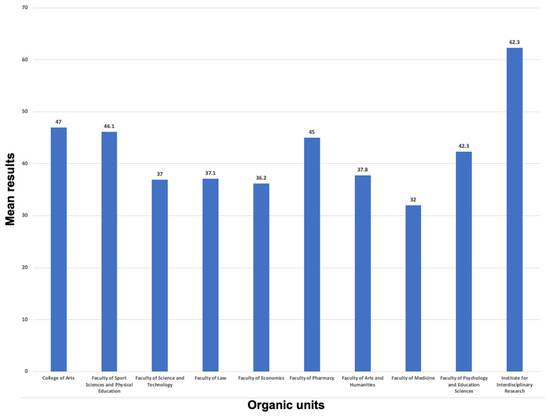
Figure 7.
Mean results by Faculty and Organic Unit.
There was an observed difference between the lowest value in the Faculty of Medicine (inherently more anchored in face-to-face interaction strategies and practical work with faculty and patients), 32 points, and the highest value in the Faculty of Sports Science and Physical Education, 46.1 points. The remaining values were relatively close to each other, indicating that there was no clear relationship between professional area and digital competence. These results were again similar to those of teachers in the study by Dias-Trindade and Santo (2021), in which humanities teachers had higher scores, while engineering teachers reported the lowest perceived digital competence. Thus, we concur with Mora-Cantallops et al. (2022), who summarised their results as follows: “also noteworthy are the significant differences in the level of self-perceived competence between different academic areas. To be more precise, there are three levels of self-perception: at the highest level are academics teaching Social Sciences and Arts and Humanities, at the middle level are those teaching Engineering and Architecture, and at the lowest level are those teaching Science and Health Sciences” (p. 37).
4.4. Teaching Experience
In the PISA 2021 report (OECD 2019), it was suggested that there is evidence that younger teachers sometimes lack experience regarding the pedagogical uses of different technologies, while older teachers sometimes lack the technical knowledge needed for use of technology to enhance learning. Therefore, the relationship between teachers’ experience and the results obtained for the self-assessment questionnaire was also analysed. (Figure 8).
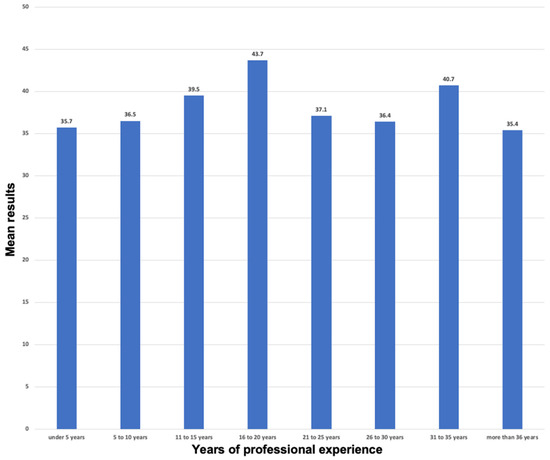
Figure 8.
Distribution by teaching experience.
Again, the extremes in level of experience were associated with the weakest results: teachers with more than 36 years of service, or less than five, had average scores of 35.4 and 35.7, respectively. Teachers with between 16 and 20 years of teaching experience had the highest average score, 43.7 points. However, once again, the results were very similar and there was no apparent correlation between digital competence and teaching experience. These results are similar to those cited in the PISA report. If younger teachers lack experience and older teachers’ technical knowledge, perhaps teachers with between 16 and 20 years of experience combine greater digital competence with the security of several years of experience.
However, when we observe the average levels of results by length of service (Figure 9), it is precisely the group with between 16 and 20 years of service in which the highest percentage of teachers with an overall result at level A1 occur (20%), even though, added to the results at level A2, this represents a lower percentage than that of almost all the other groups, with the exception of the group of teachers with between 31 and 35 years of experience.
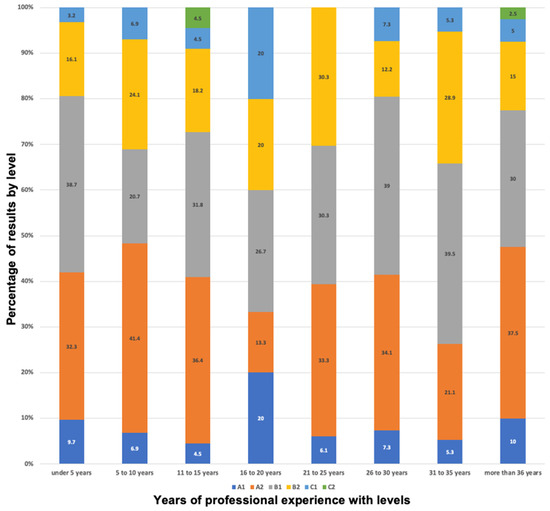
Figure 9.
Distribution by level and teaching experience.
These results lead us to conclude that there is no strong association here either. Necessarily, teaching experience may have advantages, which, combined with other characteristics, may contribute to a higher level of digital competence.
5. Discussion
The results obtained with respect to gender, age, scientific/organisational area, and teaching experience are consistent with those of related studies. Cabero-Almenara and colleagues (Cabero-Almenara et al. 2021), after analysing different studies, found that teachers often have “low digital competence, not in accordance with the objectives to be achieved set by the emerging technologies of the Horizon reports whose digital teacher competence is the key to training future graduates for the professions of the twenty-first century” (p. 4702).
Cabero-Almenara and colleagues (Cabero-Almenara et al. 2021) state that “training in digital competence of Higher Education teachers is a key piece to be able to have a quality education” and that “having a basic-intermediate level is no longer enough” (p. 4703).
Beyond the need to undertake training—something that several pedagogical scholars in higher education have stated (e.g., Zabalza 2004; Gaeta and Prata-Linhares 2013; Lima and Loureiro 2015)—Dias-Trindade and Ferreira (2022) suggest that sources such as DigCompEdu and, in particular, the self-assessment questionnaires derived from them are fundamental for higher education teachers to assess what type of training is needed to improve the quality of their teaching practice, particularly regarding the integration of digital technologies in their pedagogies.
Figure 10 presents the results of two units with similar global results (the Faculty of Science and Technology with 37 points and the Faculty of Arts and Humanities with 37.8 points) in two different areas of the DigCompEdu framework: Area 3, Teaching and learning, and Area 6, Facilitating learners’ digital competences.
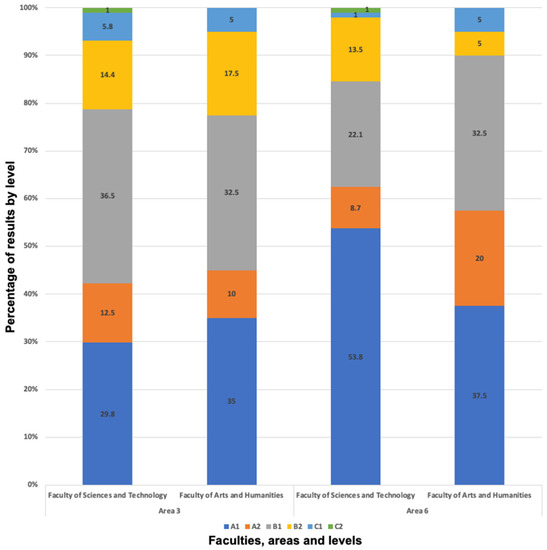
Figure 10.
Comparison of results from Areas 3 and 6 at the Faculties of Science and Technology and Arts and Humanities.
Based on the results, the Faculty of Science and Technology had many more training needs in Area 6, where the lowest levels (A1 and A2) represented 62.5% of the results, than in Area 3. The same situation was also observed for the Faculty of Arts and Humanities.
Thus, the findings lead us to emphasise the importance of teacher training to overcome the weaknesses found, weaknesses which are only partially associated with age, gender, academic area or experience. Where the results do not suggest a clear correlation, or, as Wang et al. (2013) suggest, where there is a continuum of outcomes rather than a dichotomy associated with the variables examined, the focus should be on analysis of what can be done once the existing weaknesses are understood.
6. Conclusions and Limitations of the Study
The objective of this study was to determine if there were significant differences regarding digital competence according to gender, age, faculty or teaching experience, to understand what kind of CDP activities can or should be promoted. The results presented show that it is more important for the University to invest in preparing training for its staff in a specific area of digital competence, rather than trying to adapt it to different faculties, age, gender or even teaching experience.
Based on these results as a sample of the reality of perceived digital competence and training needs, it will be possible for the institution to recommend specific training to its teachers, training which, consistent with a perspective of digital empowerment, can contribute to pedagogical innovation within the institution. It must be accepted that the evolution of technology is constant and that, if not supported, teachers will be held hostage to a “fast evolving and chaotic Wild West of digital apps” (Guernsey et al. 2012, p. 15).
In this regard, Fidelix (2016) stated that “one of the aspects in the training of the contemporary pedagogue is directly related to the opening to welcome ICT, so that it is possible to develop an investigative practice articulating the curricular components relating the technologies to the curriculum” (p. 160).
We return to the proposals of the University of Coimbra and the UC-AIPED project described at the beginning of this paper. The training proposals of the UC have incorporated different initiatives, many of them seeking to connect pedagogical practice that uses active methodologies and digital resources. As an example, we highlight the workshop “Monitoring and assessment strategies with digital resources”, which presented as objectives to be achieved, “to know methods and digital strategies for the development of assessment in an educational context; to develop competences in the use of digital technologies for continuous and final assessment through diversified and innovative resources; to prepare digital resources that allow the analysis and monitoring of students’ evolution”. Starting from the current framework, guided by the Bologna Process, this workshop seeks to enable participants to develop authentic learning experiences and evaluations, incorporating contemporary tools and resources to maximise the learning of contents in context and to develop knowledge, competences, and personal attitudes, by focusing on three specific domains: assessment strategies; evidence analysis; planning and feedback. These three domains in combination are designed to support work with digital technologies that makes use of different types of evidence with students to inspire and guide them, and assist in the construction of their knowledge.
In other words, the workshop represents a practical proposal for the use of digital technologies dedicated specifically to the development of digital competences related to Area 6 of the European reference DigCompEdu—Assessment.
Furthermore, we believe that, based on the perceptions of weakness obtained from the self-assessment questionnaire, in this case, taking the example of area 4, which is related to the workshop developed and mentioned above (“Monitoring and assessment strategies with digital resources”), it will be possible for the University to promote pedagogies that will enable the development of competencies, such as creativity and critical thinking, as presented in different reports, such as those of the OECD (2005) and WEF (2015).
As mentioned at the beginning of this paper, it is understood that to promote effective teaching of digital competence, it is necessary to understand where difficulties may exist and, above all, how to adapt CPD proposals to integrate those same digital competences in pedagogical innovation practices.
This proposal follows the ideas advocated by Mora-Cantallops and colleagues (Mora-Cantallops et al. 2022), who state in their work that, “In today’s universities, it is essential for teaching staff to have the digital competences that will enable them to carry out their work in the areas of teaching and assessment as effectively as possible” (p. 38).
Cabero-Almenara and colleagues (Cabero-Almenara et al. 2021) also support this view, reinforcing the importance of training that empowers teachers to create innovative educational environments, and in which digital technology plays a role that enhances teaching and learning processes.
While different authors have confirmed the need for continuous training (Bilbao-Aiastui et al. 2021), this study sought to demonstrate the importance of training that is aligned with the real needs of teachers. This includes benefitting from the added value of benchmarks and of self-assessment tools, such as the DigCompEdu Check In, which allow teachers, who often view research work as important in their career, to manage their activities and acquire digital competences that help them to change practices and adapt to the training needs of 21st century students.
Finally, it is acknowledged that the sample for this study is limited as only 12.2% of the teaching staff of the institution responded. However, the sample included teachers from all the organic units. Although other factors may influence the results, this study demonstrates the importance of knowing in detail teachers’ perceptions of their digital competences in different areas of their profession and, above all, how to organise training to reduce weaknesses and enhance pedagogical practices in line with what is considered necessary for higher education today. It would be interesting to increase the number of participants and to collect more details, for example, by using semi-structured interviews to provide more in-depth information.
Author Contributions
S.D.-T. and C.A. contributed to the design and implementation of the research, to the analysis of the results and to the writing of the manuscript. All authors have read and agreed to the published version of the manuscript.
Funding
The production of this text is supported by FCT ref. UIDB/00460/2020 and by the Centre for Interdisciplinary Studies.
Institutional Review Board Statement
Not applicable.
Informed Consent Statement
Informed consent was obtained from all subjects involved in the study.
Data Availability Statement
Not applicable.
Conflicts of Interest
The authors declare no conflict of interest.
References
- Bassey, Asuquo, and Valentine Joseph Owan. 2019. Ethical issues in educational research, management and practice. In Encyclopedia of Instructional Leadership, Policy, and Management. Edited by Ndimele Ozo-mekuri, Ololube Nwachukwu Prince and Gift Uchenna Nwivi. Nigeria: Pearl Publishers International, pp. 1287–301. [Google Scholar]
- Benali, Mourad, Mehdi Kaddouri, and Toufik Azzimani. 2018. Digital competence of Moroccan teachers of English. International Journal of Education and Development Using Information and Communication Technology—IJEDICT 14: 99–120. [Google Scholar]
- Bilbao-Aiastui, Eider, Arantza Arruti, and Roberto Carballedo Morillo. 2021. A systematic literature review about the level of digital competences defined by DigCompEdu in higher education. Aula Abierta 50: 841–50. [Google Scholar] [CrossRef]
- Cabero-Almenara, Julio, Francisco Guillén-Gámez, Julio Ruiz-Palmero, and Antonio Palacios-Rodríguez. 2021. Digital competence of higher education professor according to DigCompEdu. Statistical research methods with ANOVA between fields of knowledge in different age ranges. Education and Information Technologies 26: 4691–708. [Google Scholar] [CrossRef] [PubMed]
- Claro, Magdalena, Alvaro Salinas, Tania Cabello-Hutt, Ernesto San Martín, David Preiss, Susana Valenzuela, and Ignacio Jara. 2018. Teaching in a Digital Environment (TIDE): Defining and measuring teachers’ capacity to develop students’ digital information and communication skills. Computers & Education 121: 162–74. [Google Scholar]
- Coiro, Julie, Michele Knobel, Colin Lankshear, and Donald Leu. 2008. Handbook of Research on New Literacies. New York and London: Routledge. [Google Scholar]
- Creswell, John. 2007. Projeto de Pesquisa: Métodos Qualitativo, Quantitativo e Misto. São Paulo: Artmed. [Google Scholar]
- Dias-Trindade, Sara. 2021. Educação, inovação e competências digitais no Ensino Superior. In O Admirável Mundo Novo—Educação Superior em Ambientes Híbridos. Edited by Cristina Albuquerque and Fábio Reis. Coimbra: Universidade de Coimbra e STHEM, pp. 18–23. [Google Scholar]
- Dias-Trindade, Sara, and António Gomes Ferreira. 2022. Relação entre formação docente e tecnologias digitais: Um estudo na Educação Básica Portuguesa. Revista da FAEEBA 31: 302–17. [Google Scholar] [CrossRef]
- Dias-Trindade, Sara, and Eniel Espírito Santo. 2021. Competências digitais de docentes universitários em tempos de pandemia: Análise da autoavaliação DigCompEdu. Revista Praxis Educacional 17: 1–17. [Google Scholar] [CrossRef]
- Dias-Trindade, Sara, and José António Moreira. 2021. Digital Education for Curriculum Development and the Acquisition of Transversal Competences. Santo Tirso: WhiteBooks. [Google Scholar]
- Dias-Trindade, Sara, José António Moreira, and António Gomes Ferreira. 2021. Evaluation of the Teachers’ Digital Competences in Primary and Secondary Education in Portugal with DigCompEdu CheckIn in Pandemic Times. Acta Scientiarum—Technology 43: e56383. [Google Scholar] [CrossRef]
- Dias-Trindade, Sara, José António Moreira, and Cristina Nunes. 2019. Escala de autoavaliação de competências digitais de professores. Procedimentos de construção e validação. Texto Livre 12: 152–71. [Google Scholar] [CrossRef]
- ENQA (The European Association for Quality Assurance in Higher Education). 2015. Standards and Guidelines for Quality Assurance in the European Higher Education Area (ESG). Brussels: EURASHE. [Google Scholar]
- Erstad, Ola. 2006. A new direction? digital literacy, student participation and curriculum reform in Norway. Education & Information Technologies 11: 415–29. [Google Scholar]
- European Commission. 2013. Abrir a Educação: Ensino e Aprendizagem Para Todos de Maneira Inovadora Graças às Novas Tecnologias e aos Recursos Educativos Abertos [COM 2013 654 Final]; Bruxelas: Serviço de Publicações da Comissão Europeia. Available online: http://www.ipex.eu/IPEXL-WEB/dossier/files/download/082dbcc540a5439001416e35239b249b.do (accessed on 23 June 2022).
- European Parliament and the Council. 2006. Recommendation of the European Parliament and the Council of 18 December 2006 on Key Competences for Lifelong Learning. Official Journal of the European Union L394. Available online: https://eur-lex.europa.eu/legal-content/EN/TXT/PDF/?uri=OJ:L:2006:394:FULL&from=EN (accessed on 23 June 2022).
- Ferrari, Anusca. 2012. Digital Competence in Practice: An Analysis of Frameworks. JRC Technical Reports. Luxembourg: Publications Office of the European Union. [Google Scholar]
- Fidelix, Cristiane. 2016. Formação inicial de professores: Tecnologias no currículo das instituições de ensino superior do município de São Paulo. In Congresso Regional sobre Tecnologias na Educação, Brasil, 23–25 de maio 2016. Rio Grande do Norte: Universidade Federal do Rio Grande do Norte, pp. 158–69. [Google Scholar]
- From, Jorgen. 2017. Pedagogical digital competence—Between values, knowledge and skills. Higher Education Studies 7: 43–50. [Google Scholar] [CrossRef]
- Gaeta, Maria Cecília Damas, and Martha Maria Prata-Linhares. 2013. Formação de professores do Ensino Superior: Experiências curriculares em cursos Lato Sensu. Olhar de Professor 16: 343–55. [Google Scholar] [CrossRef]
- Gansmø, Helen. 2009. Fun for all = digital competence for all? Learning Media and Technology 34: 351–55. [Google Scholar]
- Gorozidis, Georgios, and Athanasios Papaioannou. 2014. Teachers’ motivation to participate in training and to implement innovations. Teaching and Teacher Education 39: 1–11. [Google Scholar] [CrossRef]
- Government of Portugal. 2017. Portugal INCoDe.2030: Iniciativa Nacional de Competências Digitais e.2030. República Portuguesa. Available online: https://www.incode2030.gov.pt/sites/default/files/incode2030_pt.pdf (accessed on 23 June 2022).
- Guernsey, Lisa, Michael Levine, Cynthia Chiong, and Maggie Severns. 2012. Pioneering Literacy in the Digital Wild West: Empowering Parents and Educators. Washington, DC: Campaign for Grade-Level Reading. Available online: http://gradelevelreading.net/wp-content/uploads/2012/12/GLR_TechnologyGuide_final.pdf (accessed on 22 June 2022).
- ICED (International Consortium for Educational Development). 2014. The Preparation of University Teachers Internationally. Available online: http://icedonline.net/the-preparation-of-university-teachers-internationally-report/ (accessed on 22 June 2022).
- Ilomäki, Liisa, Anna Kantosalo, and Minna Lakkala. 2011. What Is Digital Competence? In Linked Portal. Brussels: European Schoolnet (EUN). Available online: https://helda.helsinki.fi//bitstream/handle/10138/154423/Ilom_ki_etal_2011_What_is_digital_competence.pdf?sequence=1 (accessed on 22 June 2022).
- Ilomäki, Liisa, Sami Paavola, Minna Lakkala, and Anna Kantosalo. 2016. Digital competence-an emergent boundary concept for policy and educational research. Education and Information Technologies 21: 655–79. [Google Scholar] [CrossRef]
- Lima, Luciana, and Robson Loureiro. 2015. A utilização das tecnologias digitais da Informação e Comunicação no contexto da docência no Ensino Superior. In Anais Online do IX Colóquio Internacional Educação e Contemporaneidade, 17–19 setembro 2015. Aracaju: Universidade Federal de Sergipe. [Google Scholar]
- Mainardes, Jefferson, and Isabel Cristina de Moura Carvalho. 2019. Autodeclaração de princípios e de procedimentos éticos na pesquisa em Educação. In Ética e Pesquisa em Educação. Subsídios. Edited by Anped—Associação Nacional de Pós-Graduação e Pesquisa em Educação. Rio de Janeiro: ANPEd, vol. 1, pp. 129–32. [Google Scholar]
- Mishra, Punya, and Matthew Koehler. 2006. Technological Pedagogical Content Knowledge: A new framework for teacher knowledge. Teachers College Record 108: 1017–54. [Google Scholar] [CrossRef]
- Mora-Cantallops, Marçal, Andreia Inamorato dos Santos, Cristina Villalonga-Gómez, Juan Rámon Lacalle Remigio, Juan Camarillo Casado, José Manuel Sota Eguzábal, Juan Rámon Velasco, and Pedro Miguel Ruiz Martínez. 2022. The Digital Competence of Academics in Spain. A Study Based on the European Frameworks DigCompEdu and OpenEdu. EUR 31127 EN. Luxembourg: Publications Office of the European Union, JRC129320. [Google Scholar] [CrossRef]
- Nóvoa, António. 2000. Vidas de Professores. Porto: Porto Editora. [Google Scholar]
- OECD (Organisation for Economic Cooperation and Development). 2005. The Definition and Selection of Key Competencies. Executive Summary. The DeSeCo Project. Available online: http://www.oecd.org/dataoecd/47/61/35070367.pdf (accessed on 23 June 2022).
- OECD (Organization for Economic Cooperation and Development). 2019. TALIS 2018 Results (Volume I): Teachers and School Leaders as Lifelong Learners. TALIS. Paris: OECD Publishing. [Google Scholar] [CrossRef]
- Ota, Marcos, and Sara Dias-Trindade. 2020. Ambientes digitais de aprendizagem e competências digitais: Conhecer o presente para agir num futuro pós-COVID. Revista Interfaces Científicas—Educação 10: 211–26. [Google Scholar] [CrossRef]
- Punie, Yves, and Christine Redecker. 2017. European Framework for the Digital Competence of Educators: DigCompEdu. EUR 28775 EN. Luxembourg: Publications Office of the European Union. [Google Scholar] [CrossRef]
- Sánchez-Caballé, Anna, and Francesc Marc Esteve-Mon. 2022. Digital teaching competence of university teachers: A comparative study at two European universities. Australasian Journal of Educational Technology 38: 50–61. [Google Scholar] [CrossRef]
- Santo, Eniel Espírito, Sara Dias-Trindade, and Rafaela Santos Reis. 2022. Self-Assessment of Digital Competence for Educators: A Brazilian Study with University Professors. Research, Society and Development 11: e26311930725. [Google Scholar] [CrossRef]
- Santos, Cassio, Neuza Pedro, and João Mattar. 2021. Competencia digital de profesores de educación superior: Análisis de factores académicos e institucionales. Obra Digital 21: 69–92. [Google Scholar] [CrossRef]
- SPCE (Sociedade Portuguesa de Ciências da Educação). 2014. Carta Ética. Instrumento de Regulação ético-Deontológica. Porto: SPCE. [Google Scholar]
- INTEF (The National Institute of Educational Technologies and Teacher Training). 2017. Common Digital Competence Framework for Teachers. Available online: https://aprende.intef.es/sites/default/files/2018-05/2017_1024-Common-Digital-Competence-Framework-For-Teachers.pdf (accessed on 22 June 2022).
- Tomás-Rojas, Ambrosio, Úrsula Freundt-Thurne, Eliana Gallardo-Echenique, and Jorge Bossio. 2021. Self-Perception of Digital Competences Among Peruvian Teachers. Paper presented at CISETC 2021: International Congress on Educational and Technology in Sciences, Chiclayo, Peru, November 16–18. [Google Scholar]
- Universidade de Coimbra. 2020. Despacho n.º 10556/2020. Diário da República, n. 211/2020. Série II. Lisbon: Universidade de Coimbra, pp. 176–78. [Google Scholar]
- Wang, Qian, Michael Myers, and David Sundaram. 2013. Digital natives und digital immigrants. Wirtschaftsinformatik 55: 409–20. [Google Scholar] [CrossRef]
- WEF (World Economic Forum). 2015. New Vision for Education: Unlocking the Potential of Technology. Cologny and Geneva: World Economic Forum. [Google Scholar]
- WEF (World Economic Forum). 2018. World Economic Forum Report. Available online: https://www.weforum.org/reports/the-global-competitveness-report-2018/ (accessed on 22 June 2022).
- WEF (World Economic Forum). 2020. Schools of the Future Defining New Models of Education for the Fourth Industrial Revolution. Cologny and Geneva: World Economic Forum. [Google Scholar]
- Zabalza, Miguel. 2004. O Ensino Universitário: Seu Cenário e Protagonistas. São Paulo: Artmed. [Google Scholar]
Publisher’s Note: MDPI stays neutral with regard to jurisdictional claims in published maps and institutional affiliations. |
© 2022 by the authors. Licensee MDPI, Basel, Switzerland. This article is an open access article distributed under the terms and conditions of the Creative Commons Attribution (CC BY) license (https://creativecommons.org/licenses/by/4.0/).